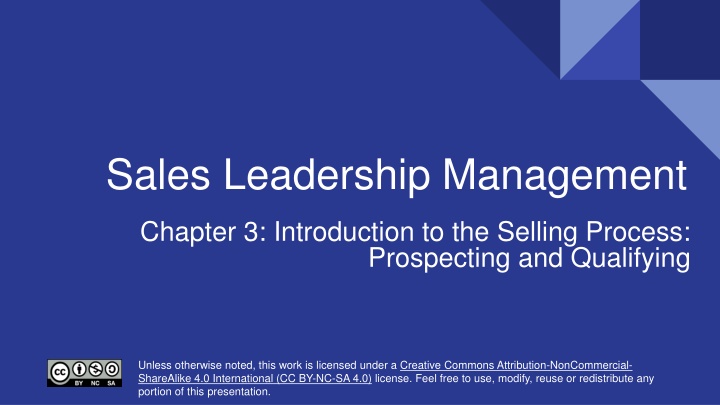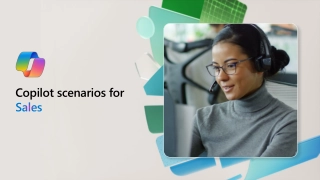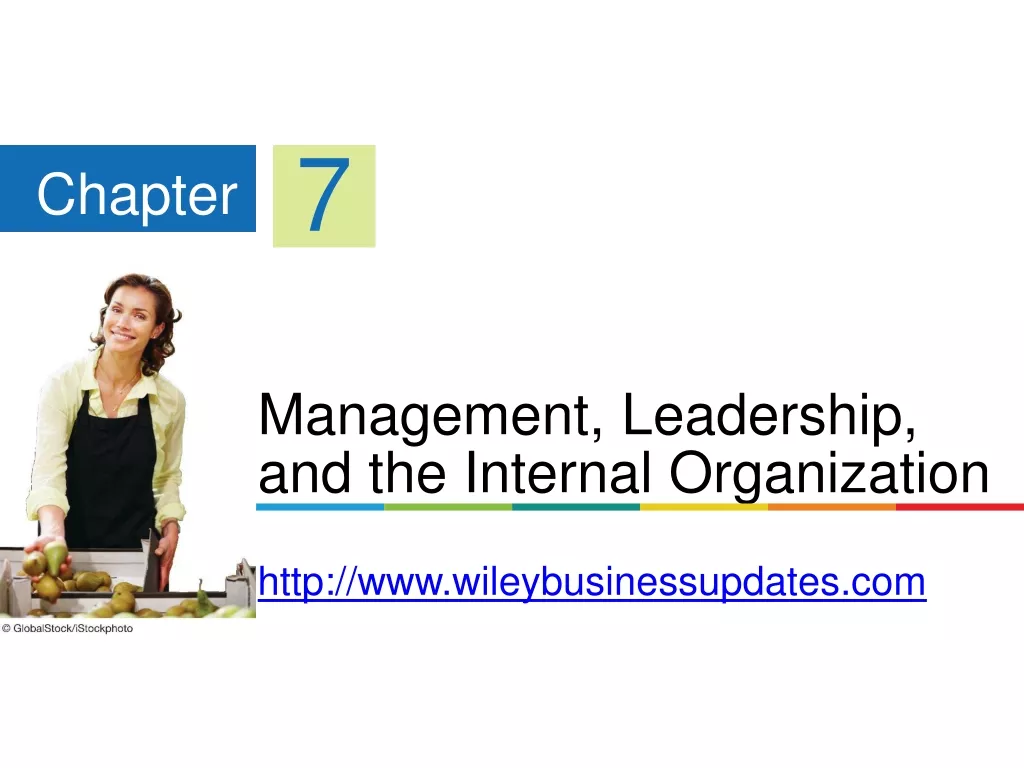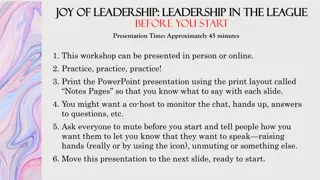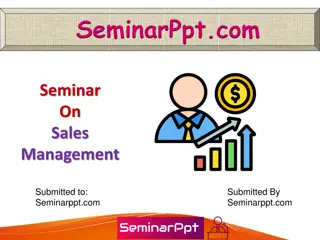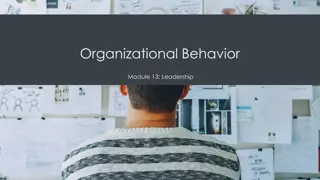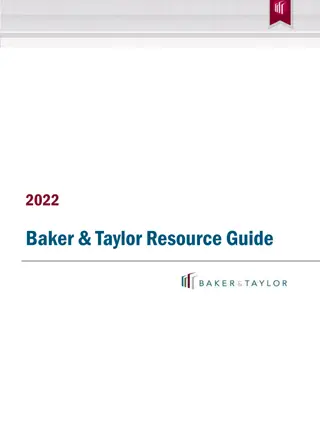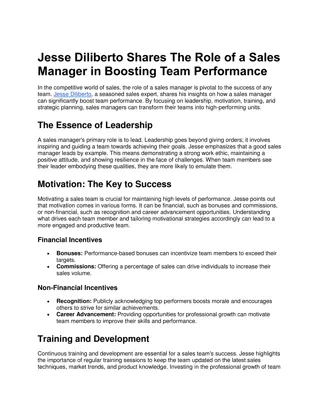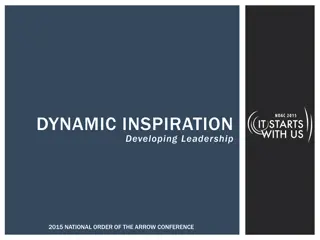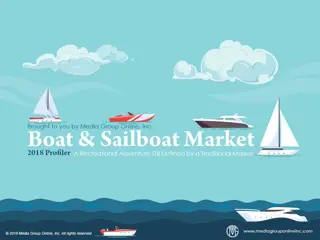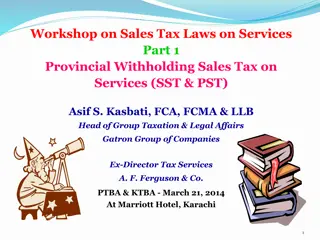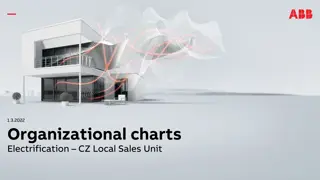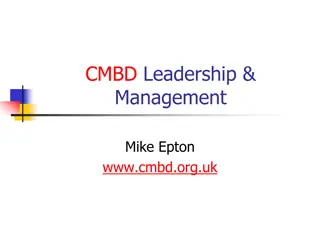Sales Leadership Management
This chapter delves into the selling process by explaining the role of the seven steps involved. It covers prospecting, identifying needs and opportunities, resources for prospecting, researching prospects, and qualifying objectives. The seven-step selling process includes prospecting and qualifying, preapproach, approach, presentation, overcoming objections, closing the sale, and follow-up. Emphasis is placed on understanding prospects, tailoring presentations, handling objections, and ultimately closing sales successfully.
Download Presentation

Please find below an Image/Link to download the presentation.
The content on the website is provided AS IS for your information and personal use only. It may not be sold, licensed, or shared on other websites without obtaining consent from the author.If you encounter any issues during the download, it is possible that the publisher has removed the file from their server.
You are allowed to download the files provided on this website for personal or commercial use, subject to the condition that they are used lawfully. All files are the property of their respective owners.
The content on the website is provided AS IS for your information and personal use only. It may not be sold, licensed, or shared on other websites without obtaining consent from the author.
E N D
Presentation Transcript
Sales Leadership Management Chapter 3: Introduction to the Selling Process: Prospecting and Qualifying Unless otherwise noted, this work is licensed under a Creative Commons Attribution-NonCommercial- ShareAlike 4.0 International (CC BY-NC-SA 4.0) license. Feel free to use, modify, reuse or redistribute any portion of this presentation.
3.0 Learning Outcomes In this chapter, we will: Explain the role of the seven steps of the selling process. Identify needs and opportunities. Discuss the role prospecting plays in the selling process. Identify resources to use when prospecting. Explain how to research a qualified prospect and list resources to conduct prospect research. List the questions to ask to meet qualifying objectives.
3.1 Its A Process: Seven Steps To Successful Selling Seven-Step Selling Process (Solomon et al., 2008) 1. Prospect and qualify 2. Preapproach 3. Approach 4. Presentation 5. Overcome objections 6. Close the sale 7. Follow-up Examples: The Seven-Step Selling Process in the B2C & B2B Market Selling Steps by Freddy Vale, CC BY-NC-SA 4.0
3.2 Solving, Not Selling Step 1: Complete a Needs and Opportunity Analysis Step 2: Brainstorm Solutions and Generate Ideas Know your problem or opportunity. Generate; don t evaluate. Push beyond the wall. Seek strategic stimuli. Step 3: Identify General and Specific Benefit Statements General benefit statements, as opposed to specific benefit statements, are broad enough that they would be important to most people. The specific benefit statement identifies the way a solution addresses a prospect s particular situation and needs, on the other hand, comes once you ve grabbed your prospect s attention.
3.3 The Seven Steps Of Selling Step 1: Prospecting and Qualifying A prospect is a lead that is qualified or determined to be ready, willing, and able to buy. It s much more fruitful to invest your time with a qualified prospect, one who has the desire or ability to buy the product or service. Step 2: Pre-approach Chapter 5 A good salesperson researches their prospect, the market, familiarizing themselves with the customer s needs, and learning all the relevant information regarding the product and service. Step 3: Approach Chapter 5 This usually involves introductions, making some small talk, asking a few warm-up questions, and generally explaining who you are and whom you represent. Photo by Rudy and Peter Skitterians, Pixabay
3.3 The Seven Steps Of Selling Step 4: Presentation Chapter 6 The presentation should be tailored to the customer, explaining how the product meets that person or company s needs. Step 5: Handling Objections Chapter 6 After you ve made your sales presentation, it s natural for your customer to have some hesitations or concerns called objections. Step 6: Closing the Sale Chapter 7 Eventually, if your customer is convinced your product will meet their needs, you close by agreeing on the terms of the sale and finishing up the transaction. Step 7: Following Up Chapter 7 The follow-up is an important part of assuring customer satisfaction, retaining customers, and prospecting for new customers.
3.4 Prospecting: A Vital Role In The Selling Process Finding leads (or people who might be prospects) is the most vital part of the selling process you can t make a sale without identifying the people to whom you ll be selling. The Value of a Lead The Sales Funnel An illustration of the sales funnel the sales process begins with a large pool of prospects and ends with a more focused number of buyers. It is a helpful way to visualize the process of finding and qualifying your customers and effectively illustrates the value of identifying a large pool of potential prospects. Prioritizing Leads Understand how to use the sales funnel to maximize leads Figure 3.4.2 Traditional Sales Funnel by Freddy Vale CC BY-NC-SA 4.0
3.5 Go Fish: Resources To Help You Find Your Prospects Tips for Identifying New Customers Where to Find Prospects Existing customers 1. It costs anywhere from five to 25 times more to attract a new customer than to keep an existing customer. Referrals 2. There s nothing more powerful than getting information about a product or service from a friend or people you trust before you buy. Networking and social networking 3. Networking is the art of building alliances or mutually beneficial relationships.
3.5 Go Fish: Resources To Help You Find Your Prospects Business directories in print 4. Online databases and directories 5. Newspapers, trade publications, and business journals 6. Trade shows and events 7. Advertising and direct mail 8. Cold calling 9. 10. Being a subject matter expert Photo by Pexels via Pixabay
3.6 Researching Your Prospect: Going Deeper About the Company Demographics/ Company news/ Financial performance About the Company s Customers Customer demographics/ Size of customer base/ What customers are saying about your prospect About the Current Buying Situation Type of Purchase/ Competitor/Current Provider/ Current Pricing About the Contact Person Title and Role in the Company/ Professional Background/ Personal Information/ Essential Problem(s) Your Contact Needs to Solve/ Motivation for Buying About Your Existing Customers Opportunities to Expand the Relationship/ Opportunities for Synergy/ Sources of Information
3.7 Qualifying Your Prospects This qualifying technique is called MANA (money, authority, need, and access). Does he or she have money to purchase the product or service? Does he or she have the authority to make the buying decision? Does your prospect have a need? Do you have access to the influencer or decision makers? MANA by Freddy Vale CC BY-NC-SA 4.0
3.8 Key Takeaways & Terms Approach Qualifying Closing Precall planning worksheet Follow-up Preapproach General benefit statement Right questions Lead Sales funnel MANA Service-level agreement (SLA) Networking Specific benefit statement Objections Synergy Prospecting Prospect
3.9 Test Your Knowledge Link: Questions Photo by Gerd Altmann via Pixabay
